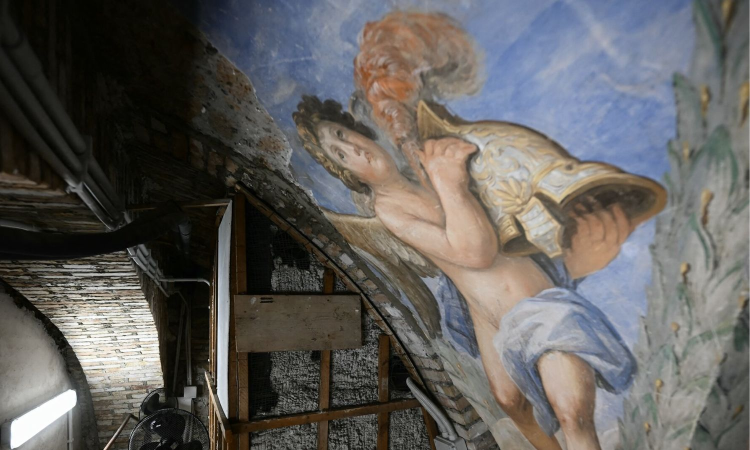Hidden Above a Trap Door, 17th-Century Frescoes Come to Light
Researchers have since determined that the frescoes Renzoni happened upon were most likely created by Carlo Maratta, one of the last masters of Baroque classicism, along with two of his students, Girolamo Troppa and Francois Simonot.

A trap door in the Pompeian Room of the 16th-century Villa Farnesina in Rome revealed previously unknown frescoes by the painter Carlo Maratta and two students
Imagine mounting a scaffold in the atrium of a historic Roman estate. You spy a small trap door in the vaulted ceiling; on inspection the hatch opens into a cavity between the new ceiling and an older one. In the older ceiling is a second trap door. When you shine a light into the darkness, broad frescoes appear, of cherubs floating amid rolling hills and thistledown clouds in a summery blue sky.
This is what Davide Renzoni, an electrician in Rome, experienced last year when he climbed up into a rabbit hole while inspecting cables in the Pompeian Hall of the Villa Farnesina, a sumptuous suburban mansion in the district of Trastevere. The villa, which dates to the 16th century, is perhaps best known for its erotically-charged frescoes depicting Cupid and Psyche designed by Raphael, the High Renaissance painter supreme.
Researchers have since determined that the frescoes Renzoni happened upon were most likely created by Carlo Maratta, one of the last masters of Baroque classicism, along with two of his students, Girolamo Troppa and Francois Simonot. Apparently executed during a late 17th century restoration of Cupid and Psyche, the forgotten works were in pristine condition and had been hidden for nearly two centuries.
“My first feeling was astonishment, immense astonishment,” Renzoni said.
His feeling was shared by Virginia Lapenta, curator of the Villa Farnesina. Lapenta said she was “overcome with emotion” when Renzoni brought her up onto the scaffold and showed her the bas-relief coat of arms of the Farnese family, the noble clan that once lived at the estate. In 1579, Cardinal Alessandro Farnese the Younger purchased the property, which was renamed Villa Farnesina to distinguish it from the Palazzo Farnese across the Tiber.
Since 1944, the villa has been owned by the Accademia Nazionale dei Lincei, among the world’s oldest scientific institutions. Because of the tight quarters, the hidden frescoes remain inaccessible to the public. But live camera feeds have been set up for visitors, who mostly have come to see the Raphaels.
The villa was built from 1506 to 1510 for Agostino Chigi, a banker to popes and princes; he lent money to both Borgias and Medicis. Called “Il Magnifico” because of his lavish lifestyle and extravagant spending, Chigi reached the peak of influence and persuasion when Julius II, a major patron of Raphael and Michelangelo, ascended to the papal throne.
Chigi’s villa, with its U-shaped floor plan and open loggias, was considered one of the architectural marvels of its time. Chigi himself commissioned Raphael and a half-dozen of his contemporaries to create frescoes.
In the early 16th century, the area beneath Renzoni’s discovery included the entrance to Chigi’s private garden, the living room where he ate his meals, and the landing of the first flight of a staircase.
By late in the 17th century, the vaulted loggia ceiling had fallen into disrepair, and included loose areas of “intonaco,” the final, smooth layer of plaster used in frescoed painting. Maratta was brought in to preserve the pictures in situ.
The complicated intervention that he and his team undertook involved a hatched “tratteggio” technique, securing the plaster to the walls with hundreds of T- and L-shaped nails, and retouching the masterpieces with pastels bound in gum arabic so that their handiwork could someday be removed by what Maratta called a more “worthy” restorer.
“Apparently, restoration of ‘Cupid and Psyche’ was only part of what Maratta and his team did,” Lapenta said. “They were also responsible for entirely new artworks on the ceiling of the villa.”
In 1735, Elisabetta Farnese bequeathed Farnesina to Carlo IV, King of the Two Sicilies, and the villa became the residence of an array of Neapolitan ambassadors. In 1861, a 99-year lease was granted to the Spanish ambassador of Naples, Salvador Bermúdez de Castro, the Duke of Ripalta.
What had been Chigi’s living room staircase was removed and the current east wall was erected, effectively turning the space into a hallway. The Spanish ambassador decorated the area in a style inspired by frescoes unearthed in Pompeii, which is how it came to be known as the Pompeian Hall. The ambassador also had a false ceiling installed, thus hiding the Maratta frescoes.
In 1927, with Benito Mussolini and his National Fascist Party in control, the state bought the villa from the duke’s heirs and made it the seat of the new Royal Academy of Italy.
By the 1930s, the Pompeian Room housed the seat of the academy president, Guglielmo Marconi, the inventor of radio. The fascists turned the hall into his executive bathroom. And Maratta’s frescoes became just one more ghost in the attic.
©️The New York Times Company



